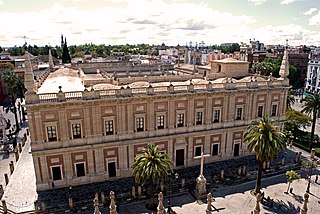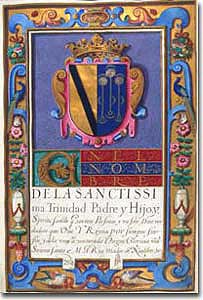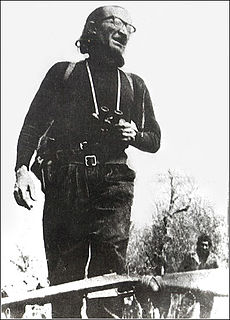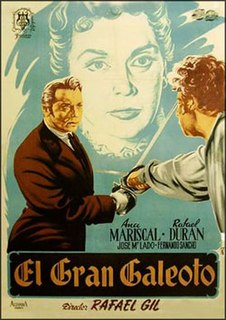
Seville is the capital and largest city of the Spanish autonomous community of Andalusia and the province of Seville. It is situated on the lower reaches of the River Guadalquivir, in the southwest of the Iberian Peninsula.

The University of Seville is a university in Seville, Spain. Founded under the name of Colegio Santa María de Jesús in 1505, it has a present student body of over 65,000, and is one of the top-ranked universities in the country.

El Comercio is a Peruvian newspaper based in Lima. Founded in 1839, it is the oldest newspaper in Peru and one of the oldest Spanish-language papers in the world. It has a daily circulation of more than 120,000. It is one of the most influential media in Peru.

Francisco de Zurbarán was a Spanish painter. He is known primarily for his religious paintings depicting monks, nuns, and martyrs, and for his still-lifes. Zurbarán gained the nickname "Spanish Caravaggio", owing to the forceful use of chiaroscuro in which he excelled.

The Spanish Golden Age is a period of flourishing in arts and literature in Spain, coinciding with the political rise of the Spanish Empire under the Catholic Monarchs of Spain and the Spanish Habsburgs. The greatest patron of Spanish art and culture during this period was King Philip II (1556-1598), whose royal palace, El Escorial, invited the attention of some of Europe's greatest architects and painters such as El Greco, who infused Spanish art with foreign styles and helped create a uniquely Spanish style of painting.

The Cathedral of Saint Mary of the See, better known as Seville Cathedral, is a Roman Catholic cathedral in Seville, Andalusia, Spain. It was registered in 1987 by UNESCO as a World Heritage Site, along with the adjoining Alcázar palace complex and the General Archive of the Indies. It is the fourth-largest church in the world as well as the largest Gothic church.

The Archivo General de Indias, housed in the ancient merchants' exchange of Seville, Spain, the Casa Lonja de Mercaderes, is the repository of extremely valuable archival documents illustrating the history of the Spanish Empire in the Americas and the Philippines. The building itself, an unusually serene and Italianate example of Spanish Renaissance architecture, was designed by Juan de Herrera. This structure and its contents were registered in 1987 by UNESCO as a World Heritage Site together with the adjoining Seville Cathedral and the Alcázar of Seville.

Juan de Valdés Leal was a Spanish painter and etcher of the Baroque era.

I, Juan de Pareja is a novel by American writer Elizabeth Borton de Treviño, which won the Newbery Medal for excellence in American children's literature in 1966.

The Trickster of Seville and the Stone Guest is a play written by Tirso de Molina. Its title varies according to the English translation, and it has also been published under the titles The Seducer of Seville and the Stone Guest and The Playboy of Seville and the Stone Guest. The play was first published in Spain around 1630, though it may have been performed as early as 1616. Set in the 14th century, the play is the earliest fully developed dramatisation of the Don Juan legend.

Juan del Castillo was a Spanish Baroque painter. Many of his paintings became famous during his time due to his pupil, Bartolomé Esteban Murillo.

The Palace of the Councils or Palace of the Duke of Uceda is a building from the 17th century located in central Madrid, Spain. It is located on the Calle Mayor, corner of calle Bailén Street.

Cristóbal Gómez de Sandoval-Rojas y de la Cerda, known as the duque de Uceda, but also titled second marquis of Cea, fifth marquis of Denia, and knight of the order of Santiago was the official minister of state, also known as the valido or valued one, for King Philip III of Spain. He engineered the exile of his father the Duke of Lerma, from the court, and his own succession to the position.

The title of Hijo Predilecto de Andalucía or in the case of a female recipient Hija Predilecta de Andalucía is an honorific title granted annually on August 10 according to decree 156/1983 of the Andalusian Autonomous Government, recognizing exceptional merit or distinction in relation to the Andalusian region, through scientific, social or political actions or works that have redounded to the benefit of Andalusia. It is the highest distinction of the autonomous community of Andalusia.

Juan Alfonso Enríquez de Cabrera y Colonna,, was hereditary 9th Admiral of Castile, 5th Duke of Medina de Rioseco and the 8th Count of Melgar

Juan Francisco Pacheco y Téllez-Girón, 4th Consort Duke of Uceda,, was a Spanish noble, viceroy of Sicily and Spanish Ambassador in Rome.

Santiago de Chuco is a city in Peru, capital of Santiago de Chuco Province, La Libertad Region.

Luis de la Puente Uceda was a Peruvian activist, politician, land reformer, and guerrilla who protested against the political coexistence and coalition between his party, American Popular Revolutionary Alliance (APRA), and the conservative forces who supported the second government of Manuel Prado Ugarteche (1956-1962), and helped pioneer land reform in Peru.

The Great Galeoto is a 1951 Spanish drama film directed by Rafael Gil and starring Ana Mariscal and Rafael Durán.



















